Solar System: 10 Things To Know This Week...Halloween Edition!
Solar System: 10 Things to Know This Week...Halloween Edition!
This week, we’re getting into the Halloween spirit with 10 spooktacular things to let your imagination run wild.

It’s not Halloween without our favorite scary characters, but what if they could stop bothering us Earthlings and go far, far away? We begin with where Dracula, Frankenstein, and other creepy creatures might choose to live if the galaxy were theirs to claim…
1. The dark (k)night.

The prince of darkness himself, Dracula, can finally seek sweet respite from the Sun. We think he’d love to live on a rocky planet named YZ Ceti d that orbits so close to its red star that it’s tidally locked keeping one side of the planet in perpetual nighttime and the other side in perpetual daytime, with a brilliant red sky (though we can guess which side Dracula will prefer).
2. Where art thou, werewolves?

Home sweet home for our furry Full Moon friends might just be on Trappist-1, a planetary system with seven planets—and where standing on one planet would mean the other planets look like six moons (some as big as our Moon in the sky).
3. Left in the dust.

We couldn’t think of anyone better to live on Proxima b than The Mummy. Hopefully this ancient monster can finally rest in peace on an exoplanet that scientists theorize is a desert planet once home to ancient oceans.
4. Cloudy with a chance of Frankenstein.

One scientific experiment we’d like to conduct: whether Frankenstein would rather live on HAT-P-11b or Kepler-3b, theorized to have fierce thunderstorms and lightning.
5. The walking dead.

We’re pretty confident that if zombies were to pick a planet, they’d want one that shares their love of death and destruction. We think they’d feel right at home on one of the pulsar planets, which are scorched by radiation because they orbit a dead star.
6. Rest your weary bones.

Skeletons need look no further: Osiris, an exoplanet that’s so close to a star that it’s “losing its flesh” as the star destroys it, seems like a perfect match.
7. Enough of the scary stuff.

For kids out there, turn pumpkin decorating into an out-of-this-world activity with space-themed stencils, from Saturn to the Sun.
8. Spooky sounds.

Cassini’s radio emissions from Saturn could give creaky doors and howling winds a run for their money. Listen to the eerie audio recordings here and find more HERE.
9. Pumpkin-carve like a NASA engineer.

NASA engineers design and build robots that can fly millions of miles to study other planets for a living—so on Halloween, they can’t help but bring that creative thinking to the grand old tradition of pumpkin carving. Take a cue from their creations with these insider tips.
10. Detective for a day.

From blades of ice on Pluto to a fuzzy, white “bunny” photographed on Mars, become a solar system sleuth and see if you can solve the stellar mysteries in this slideshow (then compare with how scientists cracked the case).
Make sure to follow us on Tumblr for your regular dose of space: http://nasa.tumblr.com.
More Posts from Xyhor-astronomy and Others

Oct. 4, 1957 - Sputnik, the Dawn of the Space Age via NASA http://ift.tt/2hNf1Yq

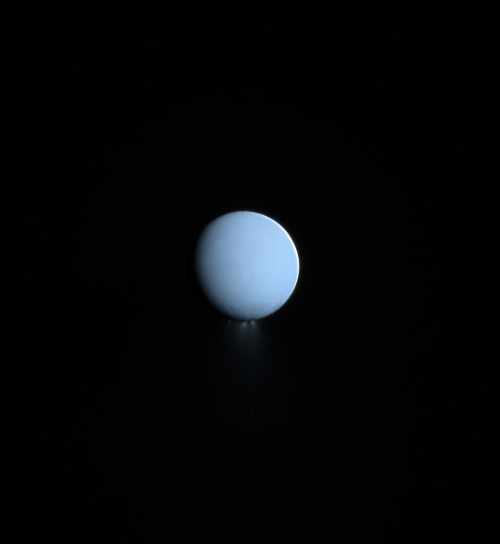



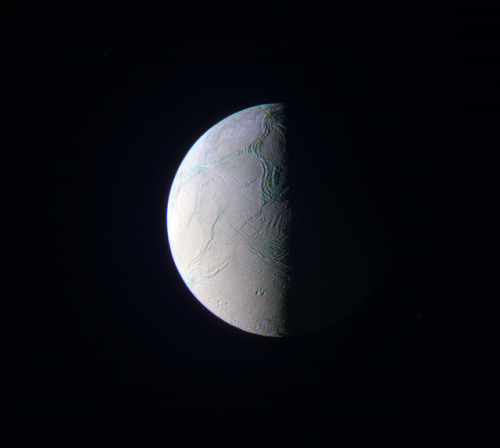

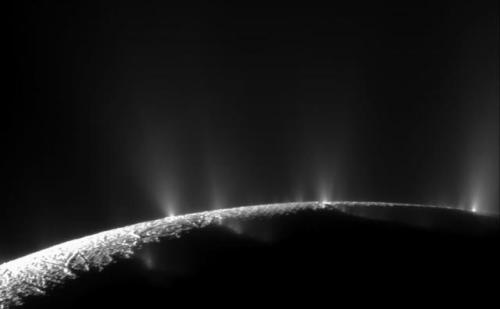

Enceladus
Enceladus is one of the major inner moons of Saturn along with Dione, Tethys, and Mimas. It orbits Saturn at a distance of 148,000 miles (238,000 km), falling between the orbits of Mimas and Tethys. It is tidally locked with Saturn, keeping the same face toward the planet. It completes one orbit every 32.9 hours within the densest part of Saturn’s E Ring, the outermost of its major rings, and is its main source.
Enceladus is, like many moons in the extensive systems of the giant planets, trapped in an orbital resonance. Its resonance with Dione excites its orbital eccentricity, which is damped by tidal forces, tidally heating its interior, and possibly driving the geological activity.
Enceladus is Saturn’s sixth largest moon, only 157 miles (252 km) in mean radius, but it’s one of the most scientifically compelling bodies in our solar system. Hydrothermal vents spew water vapor and ice particles from an underground ocean beneath the icy crust of Enceladus. This plume of material includes organic compounds, volatile gases, carbon dioxide, carbon monoxide, salts and silica.
With its global ocean, unique chemistry and internal heat, Enceladus has become a promising lead in our search for worlds where life could exist.

In 2005, Cassini’s multiple instruments discovered that this icy outpost is gushing water vapor geysers out to a distance of three times the radius of Enceladus. The icy water particles are roughly one ten-thousandth of an inch, or about the width of a human hair. The particles and gas escape the surface at jet speed at approximately 800 miles per hour (400 meters per second). The eruptions appear to be continuous, refreshing the surface and generating an enormous halo of fine ice dust around Enceladus, which supplies material to one of Saturn’s rings, the E-ring.
Several gases, including water vapor, carbon dioxide, methane, perhaps a little ammonia and either carbon monoxide or nitrogen gas make up the gaseous envelope of the plume.
Read more at: solarsystem.nasa.gov
Image credit: NASA/JPL/Cassini & Kevin Gill




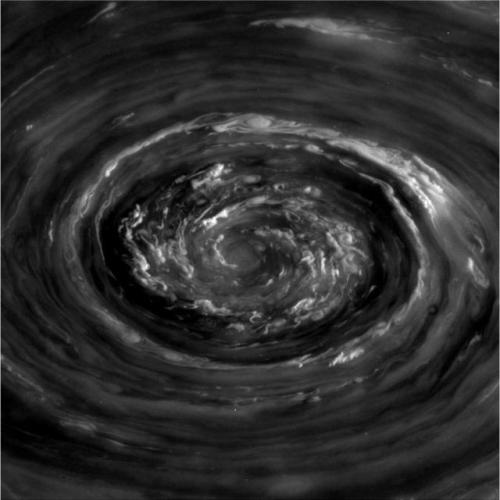
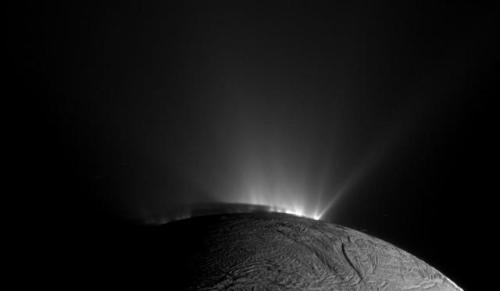

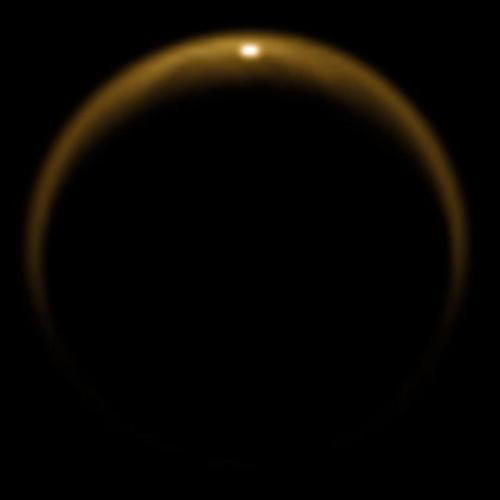

Tomorrow one of the most prolific and beloved spacecraft missions will come to an end when the Cassini spacecraft makes its final plunge into Saturn. After nearly 20 years in space and 13 years orbiting Saturn, the Cassini mission is close to running out of fuel. To prevent the craft from contaminating one of Saturn’s moons – which its mission revealed may harbor the ingredients for life – mission operators are instead sending it on a fatal dive into the gas giant.
Cassini has and will continue to provide a trove of scientific insights about Saturn and its environs. It has given us front-row seats to a storm that wrapped around the entire planet. It shed new light on Saturn’s spectacular hexagonal polar vortex and showed us the beauty of auroras on other planets. Cassini also showed us that Saturn’s moon Titan has stable hydrocarbon lakes at its surface, fed by methane rains and driven by processes unfamiliar to terrestrial ones. It also gave us paths for future exploration by documenting plumes of water ejected from Enceladus’ icebound oceans.
Cassini also holds a special place in my heart. It launched while I was in middle school, reached Jupiter while I was in college, and collected data throughout my postgraduate research career. It was an inspiration for my undergraduate spacecraft mission design projects, and it provided fun and exciting fluid dynamical discoveries throughout my time writing FYFD. It’s my favorite mission (sorry, Mars rovers, New Horizons, Dawn, and Juno!) and likely to remain so for years to come.
So thank you, Cassini, and many thanks to all the scientists, engineers, and operators who’ve worked on the mission during the decades from its conception to completion. You did a hell of a job. Godspeed, Cassini! (Photo credits: NASA/JPL)
P.S. - Tonight I’ll be helping kick off the Ig Nobel Prize ceremony. You can tune into the live webcast here. The ceremony officially starts at 6 PM Eastern time, but I recommend tuning in early, especially if you want to catch my full spiel. - Nicole
What’s Up November 2017
What’s Up For November?
Dawn pairing of Jupiter and Venus, Moon shines near star clusters, meteor activity all month long!

This month binoculars will come in handy–to view the moon, star clusters, and a close pairing of Venus and Jupiter.

You can’t miss bright Venus in the predawn sky. This month Venus pairs up with Jupiter on the morning of November 13th.

The Leonids peak on a moonless November 17th. Expect no more than 10 meteors an hour around 3:00 a.m., the height of the shower.

The Northern and Southern sub-branches of the Taurid meteor shower offer sparse counts of about 5 meteors per hour, but slow, bright meteors are common.

The nearby November Orionids peak on the 28th. In contrast to the Taurids, the Orionids are swift. But don’t expect more than 3 meteors per hour.

The moon glides by three beautiful star clusters in the morning sky this month, and a pair of binoculars will allow you to see the individual stars in the clusters. Aim your binoculars at the Pleiades and the moon on the 5th.

Then aim at the Messier or M-35 cluster and the moon on the 7th and the Beehive cluster and the moon on the 10th.

Meanwhile, at dusk, catch Saturn as it dips closer to the western horizon and pairs up with Mercury on the 24th through the 28th.

Also, Comet C/2017 O1 should still be a binocular-friendly magnitude 7 or 8 greenish object in November. Use Polaris, the North Star as a guide. Look in the East to Northeast sky in the late evening.
Watch the full What’s Up for November Video:
Make sure to follow us on Tumblr for your regular dose of space: http://nasa.tumblr.com.


A movie showing the dynamics of the inner part of the Crab Nebula made using the Chandra X-ray Observatory.
Credit: NASA/CXC/ASU/J.Hester et al.
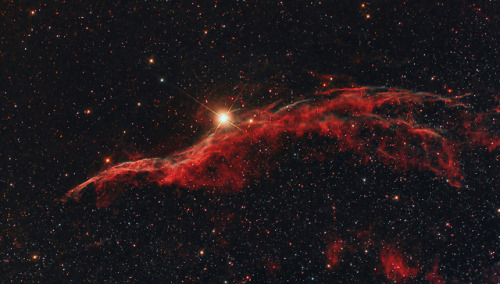
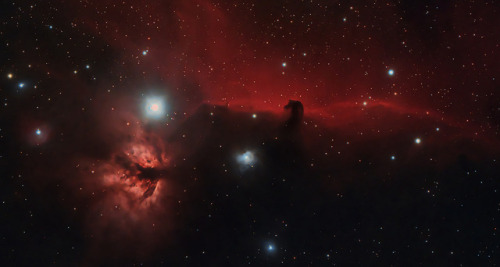
NGC 6960 (Western Veil nebula) & Horsehead Nebula and the Flame Nebula
by David Wills
Density puts things in their proper places.

The missing links between galaxies have finally been found. This is the first detection of the roughly half of the normal matter in our universe – protons, neutrons and electrons – unaccounted for by previous observations of stars, galaxies and other bright objects in space.

An irregular island
This image, courtesy of the NASA/ESA Hubble Space Telescope’s Advanced Camera for Surveys (ACS), captures the glow of distant stars within NGC 5264, a dwarf galaxy located just over 15 million light-years away in the constellation of Hydra (The Sea Serpent).
Dwarf galaxies like NGC 5264 typically possess around a billion stars — just one per cent of the number of stars found within the Milky Way. They are usually found orbiting other, larger, galaxies such as our own, and are thought to form from the material left over from the messy formation of their larger cosmic relatives.
NGC 5264 clearly possesses an irregular shape — unlike the more common spiral or elliptical galaxies — with knots of blue star formation. Astronomers believe that this is due to the gravitational interactions between NGC 5264 and other galaxies nearby. These past flirtations sparked the formation of new generations of stars, which now glow in bright shades of blue.
https://www.spacetelescope.org/images/potw
-
 delicioussludgebailifflight liked this · 1 year ago
delicioussludgebailifflight liked this · 1 year ago -
 bar2simsek liked this · 1 year ago
bar2simsek liked this · 1 year ago -
 6commet9 liked this · 1 year ago
6commet9 liked this · 1 year ago -
 oncominqstorm liked this · 2 years ago
oncominqstorm liked this · 2 years ago -
 irinakdl liked this · 4 years ago
irinakdl liked this · 4 years ago -
 cosmicbeachumbrella-blog liked this · 4 years ago
cosmicbeachumbrella-blog liked this · 4 years ago -
 devilmuhahahaking liked this · 4 years ago
devilmuhahahaking liked this · 4 years ago -
 im-nike-1111 liked this · 4 years ago
im-nike-1111 liked this · 4 years ago -
 im-nike-1111 reblogged this · 4 years ago
im-nike-1111 reblogged this · 4 years ago -
 deafeningcrusade-duck liked this · 4 years ago
deafeningcrusade-duck liked this · 4 years ago -
 lo-pica-de-eris liked this · 4 years ago
lo-pica-de-eris liked this · 4 years ago -
 cryptid-carrion reblogged this · 4 years ago
cryptid-carrion reblogged this · 4 years ago -
 tigergirlloveamnesia liked this · 4 years ago
tigergirlloveamnesia liked this · 4 years ago -
 mvrukomu liked this · 5 years ago
mvrukomu liked this · 5 years ago -
 littlebollos liked this · 5 years ago
littlebollos liked this · 5 years ago -
 pippymelodia liked this · 5 years ago
pippymelodia liked this · 5 years ago -
 tadashinagasawasunfyre liked this · 5 years ago
tadashinagasawasunfyre liked this · 5 years ago -
 galactic-dragon-pathex reblogged this · 5 years ago
galactic-dragon-pathex reblogged this · 5 years ago -
 galactic-dragon-pathex liked this · 5 years ago
galactic-dragon-pathex liked this · 5 years ago -
 awriterandimaginativedaydreamer liked this · 5 years ago
awriterandimaginativedaydreamer liked this · 5 years ago -
 stitched-up-equestrian liked this · 5 years ago
stitched-up-equestrian liked this · 5 years ago -
 yokaitrainer liked this · 5 years ago
yokaitrainer liked this · 5 years ago -
 shockwavesgirl87 liked this · 5 years ago
shockwavesgirl87 liked this · 5 years ago -
 rebdema liked this · 5 years ago
rebdema liked this · 5 years ago -
 le-sorceri liked this · 5 years ago
le-sorceri liked this · 5 years ago -
 local-town-racoon liked this · 5 years ago
local-town-racoon liked this · 5 years ago -
 azurecrucis liked this · 6 years ago
azurecrucis liked this · 6 years ago -
 iinzomniac liked this · 6 years ago
iinzomniac liked this · 6 years ago -
 nastysynth liked this · 6 years ago
nastysynth liked this · 6 years ago -
 manglednatalia liked this · 6 years ago
manglednatalia liked this · 6 years ago -
 vlbertwesker liked this · 6 years ago
vlbertwesker liked this · 6 years ago -
 goodnevilandy liked this · 6 years ago
goodnevilandy liked this · 6 years ago -
 fleisch-anzug liked this · 6 years ago
fleisch-anzug liked this · 6 years ago
For more content, Click Here and experience this XYHor in its entirety!Space...the Final Frontier. Let's boldly go where few have gone before with XYHor: Space: Astronomy & Spacefaring: the collection of the latest finds and science behind exploring our solar system, how we'll get there and what we need to be prepared for!
128 posts